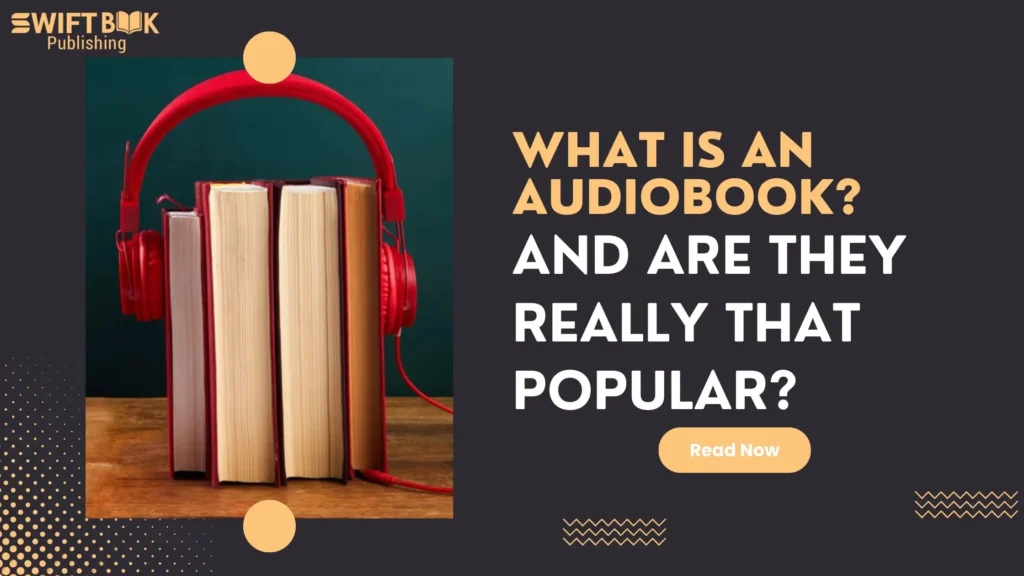Ever wished you could “read” a book while jogging, commuting, or even cooking dinner? Enter the world of audiobooks. But what is an audiobook, exactly? It’s a professionally narrated recording of a book that lets you listen to your favourite stories anytime, anywhere. From their humble beginnings on vinyl records to today’s digital streaming platforms like Audible, audiobooks have revolutionized how we consume literature. With features like adjustable playback speeds, sleep timers, and immersive sound effects, they’re more than just a convenience—they’re a gateway to storytelling for busy lives. Curious why audiobooks are taking the UK by storm? Let’s explore.
What Is an Audiobook?
The Definition of an Audiobook
If you’ve ever wished you could ‘read’ a book while doing something else—like commuting, working out, or even just relaxing—then you’ve already grasped the magic behind what an audiobook is. Simply put, an audiobook is a recorded version of a book that you can listen to instead of reading the text. Think of it as a storytelling experience, but instead of flipping pages, you’re pressing play.
A Brief History of Audiobooks
Audiobooks aren’t some flashy new trend; they’ve been around for decades. The concept started in the 1930s when the American Foundation for the Blind produced recordings of books on vinyl records for visually impaired readers. By the 1970s, cassette tapes made audiobooks more accessible to the general public, and later, CDs took over in the ‘90s. However, the real revolution came with the internet and smartphones. Digital formats like MP3s and streaming services have made it easier than ever to access a vast library of books anytime, anywhere. Today, platforms such as Audible, Google Play Books, and Apple Books have made audiobooks a mainstream staple in the literary world.
Different Formats and Platforms
Audiobooks come in different formats, catering to various preferences and technologies. While CDs are still used by some, they’ve largely been replaced by downloadable MP3s and streaming options. Digital platforms allow listeners to stream audiobooks instantly or download them for offline use, making them a perfect fit for modern lifestyles. Popular audiobook platforms, like Audible, Scribd, and Libro.fm, offer extensive libraries spanning fiction, nonfiction, self-improvement, and even full-cast dramatized performances.
Why Audiobooks Are Gaining Popularity
One of the biggest reasons audiobooks are booming in popularity is their accessibility. Whether you’re a book lover short on time, someone who absorbs stories better by listening, or a person with visual impairments, audiobooks make literature more inclusive. With features like playback speed adjustments, bookmarks, and even AI-generated narrators starting to emerge, they are more flexible than traditional reading methods.
How Does an Audiobook Work?
Now that we’ve covered what an audiobook is, let’s dive into how they work. Behind every smooth listening experience is a combination of sophisticated technology, careful production, and user-friendly accessibility. From the moment a book is transformed into an audio format to how listeners engage with it, every step plays a crucial role in making audiobooks a growing part of modern reading culture.
The Technology Behind Audiobooks
The production of an audiobook isn’t as simple as reading into a microphone. It’s a multi-step process that ensures the final product is engaging, polished, and high-quality.
- Recording Process – The first step is narration. A professional voice actor (or in some cases, the author) reads the book in a controlled environment, usually a soundproof studio, to eliminate background noise. The tone, pacing, and emotion in the narration all play a crucial role in bringing the book to life. Some audiobooks also include multiple voice actors, background sound effects, or even music to enhance the experience.
- Audio Editing & Post-Production – Once the narration is recorded, sound engineers edit the files. This involves removing mistakes, adjusting pauses for natural speech patterns, eliminating background noise, and enhancing clarity. Equalization and compression ensure that volume levels remain consistent, preventing any jarring fluctuations in sound. High-quality audiobooks go through meticulous editing to produce a smooth, immersive experience.
- Formatting & Encoding – After editing, the audiobook is converted into different file formats. While older audiobooks were distributed on CDs, today’s formats are digital, mainly MP3s and AACs, which are optimized for streaming and downloading. This makes audiobooks lightweight enough to be played on mobile devices without consuming too much storage.
- Distribution & Platform Integration – Once ready, the audiobook is uploaded to platforms such as Audible, Google Play Books, Apple Books, and Scribd, where it becomes available for purchase, subscription, or borrowing. Some audiobooks are distributed exclusively through a single platform, while others are made available on multiple services to maximize reach.
- AI & Future Innovations – The industry is also exploring AI-generated narrators, which are becoming more advanced. While human narration is still preferred for its emotional depth, AI-driven voiceovers are improving rapidly, making it possible to create audiobooks more quickly and affordably.
Accessing Audiobooks
Audiobooks have become more accessible than ever, thanks to digital platforms that allow users to listen on various devices. Unlike traditional books, which require physical copies, audiobooks are available instantly through apps, websites, and even public libraries.
- Streaming & Downloading – Most audiobook services allow users to stream directly from their apps, which means no need for storage space. However, they also offer the option to download audiobooks for offline listening—perfect for long trips or areas with poor internet connectivity.
- Subscription Models vs. One-Time Purchases – Platforms like Audible operate on a subscription model, where users pay a monthly fee for access to audiobooks. Others, like Google Play Books, allow users to purchase audiobooks individually without needing a subscription.
- Library Access – Many public libraries partner with platforms like Libby and OverDrive, allowing members to borrow audiobooks for free. This is a great way for budget-conscious readers to access bestsellers without paying for them.
- Smart Device Integration – Audiobooks can be played on a variety of devices, including smartphones, tablets, smart speakers (like Swift Echo and Google Nest), and even in-car entertainment systems, making them a convenient option for multitasking.
Enhancing the User Experience
A major reason for the growing popularity of audiobooks is how customizable they are. Unlike traditional reading, where the experience is largely the same for everyone, audiobooks allow users to tweak their settings for a more personalized listening experience.
- Playback Speed Control – Most audiobook apps offer adjustable playback speeds, letting listeners speed up or slow down narration to match their preferences. Whether you want to finish a book quickly or savour every word, you can adjust accordingly.
- Bookmarks & Chapter Navigation – Audiobooks allow users to add bookmarks to key sections so they can easily revisit important moments. Additionally, most platforms offer seamless chapter navigation, allowing listeners to jump to specific sections without hassle.
- Sleep Timers – This feature is especially useful for bedtime listeners. With a sleep timer, the audiobook will automatically stop playing after a set period, ensuring that you don’t miss large chunks of the book if you drift off.
- Accessibility Features – Audiobooks are a game-changer for people with disabilities. They provide an alternative reading method for visually impaired individuals, dyslexic readers, and people who struggle with traditional text-based reading. Some platforms even integrate text-to-speech technology, offering synchronized reading with both audio and on-screen text.
As audiobooks continue to evolve, their features are becoming even more sophisticated. Innovations like AI-generated narrators, interactive storytelling, and immersive soundscapes are all pushing the boundaries of how we experience books.
With so many ways to enjoy audiobooks, it’s no wonder they are rapidly growing in popularity.
The Growing Popularity of Audiobooks
Building upon our understanding of how audiobooks work, it’s evident that their popularity has surged in recent years. Let’s delve into the factors contributing to this rise.
Rising Numbers
Audiobooks have become increasingly mainstream. In 2024, 38% of American adults listened to an audiobook, up from 35% in 2023. This uptick indicates a broader acceptance and consumption of audiobooks.
Why the Buzz?
Several factors contribute to the growing appeal of audiobooks:
- Convenience: Audiobooks fit seamlessly into busy lifestyles, allowing individuals to enjoy literature while commuting, exercising, or performing household chores.
- Multitasking: They enable users to combine reading with other activities, making it easier to incorporate books into daily routines.
- Accessibility: For visually impaired readers or those with reading difficulties, audiobooks offer an accessible alternative to traditional print.
Who’s Listening?
The surge in audiobook consumption is notably driven by younger demographics. Data from Spotify indicates that 57% of their audiobook listeners are between the ages of 18-34.
This trend suggests that millennials and Gen Z are embracing audiobooks as a preferred medium for content consumption.
As we move forward, it’s essential to understand the process behind creating these engaging audio experiences. In the next section, we’ll explore how to create an audiobook, providing insights into the production journey from manuscript to finished product.
Following our exploration of the growing popularity of audiobooks, it’s essential to understand the platforms that facilitate this trend. Various services offer unique features, catering to diverse listener preferences.
Popular Audiobook Platforms
- Audible: As a leading platform, Audible boasts an extensive library that has over 200,000 titles, including bestsellers and exclusive content. Subscribers receive one credit per month to redeem any audiobook, with plans starting at $14.95 monthly. Additional perks include access to Audible Originals and a user-friendly app compatible with multiple devices.
- Scribd: Offering a subscription model at $11.99 per month, Scribd provides unlimited access to a vast collection of audiobooks, eBooks, and more. While its audiobook selection may not match Audible’s in size, the inclusion of various media types offers excellent value for diverse readers.
- Libro.FM: For those keen on supporting local bookstores, Libro.fm presents a compelling choice. At $14.99 per month, subscribers receive one audiobook credit, with a portion of the proceeds benefiting a selected independent bookstore. This service combines a robust catalogue with community support.
Niche Services
- Blinkist: Catering to nonfiction enthusiasts, Blinkist offers condensed versions of books, allowing users to grasp key insights in about 15 minutes. This service is ideal for those seeking quick, informative content.
- getAbstract: Focusing on business literature, getAbstract provides summaries of a vast array of business books, making it a valuable resource for professionals aiming to stay informed without investing extensive time.
Challenges and Considerations in Audiobook Production
While audiobooks offer a dynamic way to experience literature, creating and distributing them comes with its own set of challenges. Let’s explore some key considerations for authors and producers.
1. Financial Investment
Producing a high-quality audiobook requires a significant financial commitment. Costs can range from $2,500 to $3,750 for a five-hour book, averaging about $500 to $750 per finished hour. This investment covers expenses such as professional narration, studio time, editing, and mastering.
For authors, especially those self-publishing, these costs can be substantial. It’s essential to weigh the potential return on investment and consider factors like audience demand and distribution channels when deciding to produce an audiobook.
Disclaimer: Cost may vary depending on service and complexity of project. Consider consulting with an expert first to learn more about the cost and price structure of audiobook production.
2. Ensuring Quality
The success of an audiobook heavily depends on its quality. A skilled narrator can bring a story to life, conveying emotions and nuances that enhance the listener’s experience. High-quality narration improves clarity and emotional engagement, allowing listeners to connect deeply with the story.
Investing in professional voice talent and sound engineering is crucial. The poor audio quality or lacklustre narration can detract from the content, leading to negative reviews and diminished sales.
3. Navigating a Saturated Market
The audiobook market has seen significant growth, leading to increased competition. Standing out requires strategic marketing and often leveraging unique selling points, such as exclusive content or renowned narrators.
Authors and publishers must be proactive in promoting their audiobooks, utilizing social media, author platforms, and collaborations to reach potential listeners. Building a loyal audience can help navigate the challenges of a crowded marketplace.
Final Note
So, what is an audiobook? It’s more than just a narrated book, that’s for sure. It’s a flexible, accessible, and immersive way to experience stories. Whether you’re a multitasker, a visual learner, or someone who simply loves the sound of a well-told tale, audiobooks offer something for everyone. With their growing popularity in the UK and beyond, they’re reshaping how we connect with literature. Ready to press play on your next adventure? The world of audiobooks awaits.
Frequently Asked Questions
What exactly is an audiobook?
An audiobook is a recorded version of a book narrated by a professional voice actor or the author. It allows listeners to “read” by listening, making it ideal for multitasking or for those who prefer auditory learning. Audiobooks are available in various formats, including CDs, MP3s, and streaming services like Audible and Scribd.
How do audiobooks work?
Audiobooks are created through a detailed production process. A narrator records the book in a studio, followed by editing to remove errors and enhance sound quality. The final product is formatted for digital distribution and made available on platforms like Audible, Apple Books, or Google Play. Listeners can stream or download audiobooks to their devices for offline listening.
Why are audiobooks becoming so popular?
Audiobooks are booming due to their convenience and accessibility. They allow people to enjoy books while commuting, exercising, or relaxing. Features like adjustable playback speeds, sleep timers, and offline listening make them user-friendly. Additionally, they’re a great option for visually impaired readers or those with reading difficulties.
How can I create my own audiobook?
Creating an audiobook involves several steps:
- Hire a professional narrator or narrate it yourself.
- Record in a soundproof studio to ensure high-quality audio.
- Edit the recordings to remove mistakes and enhance clarity.
- Format the files for distribution and upload them to platforms like Audible or ACX.
- Promote your audiobook through social media and author platforms to reach listeners.
What are the best platforms for audiobooks in the UK?
Popular audiobook platforms in the UK include:
- Audible: Offers a vast library and exclusive content with a subscription model.
- Scribd: Provides unlimited access to audiobooks, eBooks, and more for a monthly fee.
- Libro.fm: Supports local bookstores while offering a wide selection of audiobooks.
- Libby/OverDrive: Allows free borrowing of audiobooks through public libraries.







